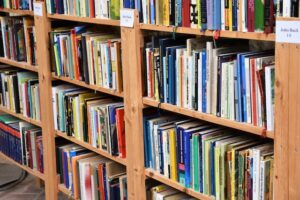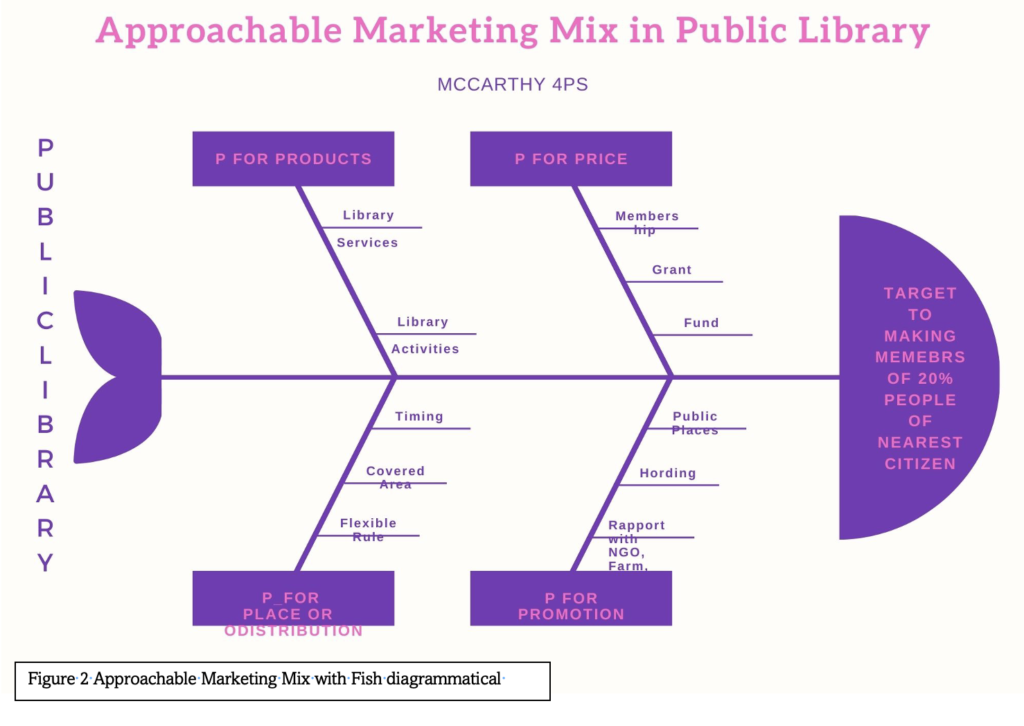An Approachable Framework of the Extended Marketing Mix towards Public Libraries
An Approachable Framework of the Extended Marketing Mix towards Public Libraries
Dr. Minaxi A P
Introduction
The public library is the source of informal education for society. The great Indian visionary and high highness, Maharaja Sayaji Rao Gaekwad III., conceived of “Vernacular libraries, a free public library where Indian citizens may enroll themselves as a pupil in the peoples’ university”. He started the state public library in 1910 at Baroda state. Mr. W. A. Borden was the first director of it, and this became the foundation for the public library and education system of India. Another Indian visionary, Dr. S. R. Rangnathan, contributed to both library administration by preparing public library legislation and by developing the Colon Classification Scheme. Today’s public libraries reach out to most areas, but they struggle to reach a growing population. We need to bridge this gap, and the extended marketing mix may be a tool to decrease the distance between people and the public library.
—The public library is working for the people and by the people—
Marketing Mix
Professor Edmund Jerome McCarthy has proposed the concept of the 4 Ps marketing mix in his book entitled Basic Marketing: A Managerial Approach. Here, he defined the 4 Ps which denote Product, Price, Place (OR Distribution), and promote a conceptual framework in the marketing mix. This theory was again updated in 1981 by Booms & Bitner. The McCarthy Ps denotes product, price, place, and promotion while the extended 3 Ps denote people, processes, and physical evidence. Public libraries are required to approach all Ps to be successful.

The McCarthy P’s for Product
The public library is working for the people and by the people, therefore the services and extended activities provided to the enrolled citizen are considered products.
P for Product_Public Library Services
- Ask Librarian
- Cooperative Cataloguing Programs
- Archival Description
- Inter Librarian Loan
- Linked Data Service
- Advance Booking of Book/Resource/Reading Space
P for Price_Public Library Income & Expenses
- Library Cess
- Membership Fee
- Service Charges
- Collection development (Purchase and subscriptions)
- Building & ICT infrastructure, etc.
P for Place_Public Library
- This entity is about the distance of both user’s site and the library location site.
- Library environments, stack area, reading area, etc.
P for Promotion_Public Library
- Workshop
- Seminar
- Children Program
- Career Advancement Seminar for students/women/professional
- Poet, Author, Comedian, Convention
P for People_Public Library
- Library members, personnel, various committee members, and invited eminent personalities.
P for Physical evidence_Public Library
- Satisfied users’ opinions, survey results, administrative documents, etc.
Objective
This is an exploratory study: a researcher has approached the extended marketing mix concept and applied the same in the public library growth. Hence, the marketing theory has decreased the distance between the public library and potential users; consequently, the specific objective is to prepare an approachable marketing model with Fishburne diagrammatical effect for the public library.
Research Question
- Does the approachable marketing model decrease the distance between the library and potential users?
- Will the role of this marketing model as a bridge to make the public library a public university?
Former Literature
 Kleindl, Brad. “Marketing practice used by the emerging American Public Library system from inception to 1930.” Journal of Micromarketing, Vol. 27, issue – 1, P 65-73. This research article explains the marketing practice of the American public library for a specific range of periods which was the Institutional Development adopted the strategies to identify the potential users’ groups and target specific market segments through the development of unique products. This can be seen as an example of the “complex flux” model, in which change in marketing practice is linked to past phenomena. Libraries developed complex marketing and promotional strategies using a mix of media to reach their targeted market segments.
Kleindl, Brad. “Marketing practice used by the emerging American Public Library system from inception to 1930.” Journal of Micromarketing, Vol. 27, issue – 1, P 65-73. This research article explains the marketing practice of the American public library for a specific range of periods which was the Institutional Development adopted the strategies to identify the potential users’ groups and target specific market segments through the development of unique products. This can be seen as an example of the “complex flux” model, in which change in marketing practice is linked to past phenomena. Libraries developed complex marketing and promotional strategies using a mix of media to reach their targeted market segments.
Inaloo, et.al., (2018) conducted a study on the “Examination of SAVE marketing mix situation in public libraries of Tehran.” In this research article all the authors are studying the application of the SAVE marketing mix in the Tehran public library. Here authors convert the marketing mix into the SAVE model where all components have been changed with its functionality. They used the following SAVE marketing mix: a. Solution instead of Products, b. Access to the Place of Supply, c. Value instead of Price, and d. Training instead of promotional activities. Hence, here a researcher can understand the applicability of marketing mix in the public library in housekeeping functions.
Muhammad Akhtar Rind & Abdul Jaleel Miriat (2020) conducted research entitled “Application of 4 Ps of Marketing Mix in Library and Information Services at Public Sector University Libraries of Jamshoro, Sindh, Pakistan” for the specific purpose to analyze the responses of the users towards promotion, price, place, and product of marketing mix at public sector universities library of Jamshoro, Sindh, Pakistan, they used a descriptive statistical method to analyzed data, they fined also that users would be happy in designing work and creative work for the library. The library has a need to conduct various promotional activities and programs to increase awareness. JIMLS Vol 3 Issue1, 2020.
Methodology
Here the exploratory methodology was used for this study. A researcher identified the potential ways to reach out to the maximum potential users of the library by brainstorming process applied through a fish-born diagram. The research question has come into the researcher’s mind during access to the census of India and determine the specific ways where the maximum public gathered; for example, The Self Employed Women Association Ahmedabad is an NGO and has more than 5 lakh women members including literate and illiterate; so, if the public library executive does approach them, then the women membership of Ahmedabad public library is increased and simultaneously their participation in library activities also increase. Hence, this study is explained in all the possible ways to reach the maximum potential library users.

Elaborative Discussion of Marketing Mix Model
The public library receives the income in form of membership fees, governmental cess, funds, donations, and grants. Since the nature of the library is a service sector the walk of life should be given services and take nominal charges in form of donations and gifts. The theoretical background of the marketing mix was already given initially; here, the important “P” is explained.
RQ1: Does the approachable marketing model decrease the distance between the library and potential users?
To resolve this question, the third P of the marketing mix is very important, as it shows the place or distribution of the product or services. As Shri Sayaji Raja said, “The public library is a people library and people university.” Hence, every person has the right to be a member, while the public library has a responsibility to reach out to the maximum number of residential citizens nearest to the library. Therefore, the library could appoint a relationship manager and they would commute to NGOs, business farms, hospital management, etc., to develop a relationship and sign the MoU. Here, a public library could plan various sessions (i.e., reading, storytelling, members gathering, etc.) weekly, fortnightly, quarterly, and monthly, on a basis as per management convenience. Hoarding, advertisement, public meeting, collaborative events with NGOs, doctors, and business farms, etc., are other techniques where public libraries attract the maximum number of citizens to be library members.
The fourth P of Promotion is another important element. Here, the first step to take into consideration for the public library is to advertise on all public stations (i.e., railway stations, bus stations, government hospitals, airports, marketplace, where the people commute regularly), inspiring people to visit the library. This is the first step towards a people’s university and will increase the membership of the library as well as the education ratio of the country. The librarian must build relationships with NGOs and businesses and other farms; they might work as an excellent marketing executive of the public library. Both NGOs and farms have been the main sources to find potential members.
RQ2: Will the role of the marketing model as a bridge make the public library a public university?
The extended marketing model should inspire citizens towards the library, while some learning opportunities will automatically be opened in the form of reading habits, knowing various journals, and hands-on practices. Talks, seminars, etc. Consequently, the marketing mix model is marking the potential library users inside the library successfully. Day by day, users could expand their knowledge by reading different books and resources informally. Hence, this model would be a bridge to make the public library a public university.
Suggestions
The following suggestions have been given by the researcher to approach the marketing mix in the public library:
- The public library is like a public university; hence the university would be full of enrolled students/learners/users. When a maximum number of residents would understand the importance of knowledge, library, and education, the growth of the nation will be reaching a high. The education ratio of the country will be increasing simultaneously the quality of study also improve because learners are free and no one restriction stopping to be learned. Here, all the learning freedom, choices, and boundlessness are given equal opportunities anywhere, though the aged learner.
- The public library may provide a good academic atmosphere to all members equally; therefore, people may get an inspirational kick to complete their inclination which doesn’t come over during the rightness of timing.
- The public library should be developed as another educational system by the government. So, the child, adulthood, and higher education may be continuous through formal educational ways while another site inside public libraries the informal education must continue for the people for their entire life.
References
Amir Inanloo, Elahe Ph.D student; Zarei, *Atefeh Assistant Professor; and Zeinolabedini, Mohsen Haji Assistant Professor,”Examination of SAVE marketing mix situation in public libraries of Tehran” (2018). Library Philosophy and Practice (e-journal). 1726.https://digitalcommons.unl.edu/libphilprac/1726
(PDF) Examination of SAVE marketing mix situation in public libraries of Tehran. Available from: https://www.researchgate.net/publication/323745857_Examination_of_SAVE_marketing_mix_situation_in_public_libraries_of_Tehran [accessed Apr 10 2023]. access on 14/10/2022.
Kleindl, Brad “Marketing practice used by the emerging American Public Library system from inception to 1930” Journal of Micromarketing, Vol. 27, issue – 1, P 65-73.
Muhammad Akhtar Rind & Abdul Jaleel Miriat (2020) conducted research entitled “Application of 4 Ps of Marketing Mix in Library and Information Services at Public Sector University Libraries of Jamshoro, Sindh, Pakistan” JIMLS, vol.3 (1). file:///C:/Users/Dr.%20Minakshi/Downloads/20.pdf access on 14/10/2022.
Cite this article in APA as: Minaxi, A. P. (2023, April 11). An approachable framework of the extended marketing mix towards public libraries. Information Matters, Vol. 3, Issue 4. https://informationmatters.org/2023/03/an-approachable-framework-of-the-extended-marketing-mix-towards-public-libraries/





